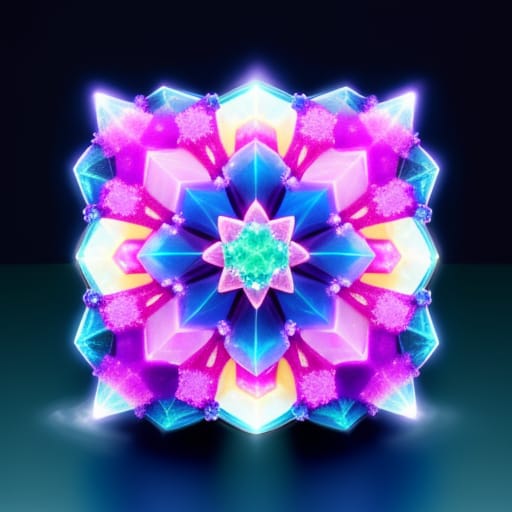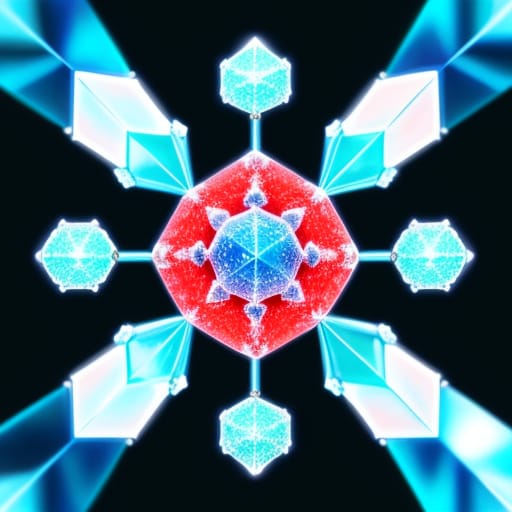Have you ever seen a crystal growing kit at a science museum gift shop and wondered, how those crystals form? Or maybe you’ve used borax before without realizing it has an amazing hidden talent – the ability to grow into giant crystals!
Crystal growth is a fascinating science experiment that reveals the structured atomic pattern found in crystalline substances like borax. With just a few household materials, you can grow your own impressive borax crystals at home.
In this beginner’s guide, you’ll learn:
- The science behind how crystals form
- Step-by-step instructions for growing borax crystals
- The chemistry that makes borax crystallize
- The unique symmetrical shapes of borax crystals
- How borax crystals compare to other crystals like salt or sugar
- The many uses of borax, from laundry booster to antifungal treatment
- The history of borax and how it was discovered
Plus plenty of tips and tricks for growing the biggest, most symmetrical borax crystals successfully!

How Do Crystals Form? The Science of Crystal Growth
Crystal growth is governed by chemistry and physics. In order for a substance to crystallize, its molecules must be able to arrange themselves into an ordered and repeating 3D pattern.
Crystallization occurs when a solution becomes supersaturated. Supersaturation means the dissolved solid cannot stay in solution anymore and must precipitate out.
The key factors affecting crystal growth are:
- Temperature – Solubility increases at higher temperatures, allowing more solute to dissolve. Lower temperatures decrease solubility, causing crystallization.
- Solubility – How much solute can dissolve in a solvent. Each substance has its own solubility limits.
- Supersaturation – When solubility limits are exceeded, forcing the solute to precipitate out of the solution.
Borax or sodium borate has a special molecular structure that allows it to easily form crystals under the right conditions. Next, we’ll look at why borax is so good at growing into giant gorgeous crystals!
What Makes Borax Such a Good Crystal Grower
Borax, also known as sodium borate, is a mineral composed of sodium, boron, oxygen and water (Na2B4O7•10H2O).
The molecular structure of borax contains distinct unit cells that stack together in a three dimensional repeating pattern, allowing large crystals to form.
Compare this to table salt, which also readily forms crystals but in smaller cube shapes. The simpler cube structure of salt limits its crystal size.
Borax also has high solubility, which allows a super-saturated solution to form easily. Large amounts of borax can dissolve in hot water, then as the solution cools the excess borax precipitates out, creating the crystals.
Lastly, borax dissolves much better in hot water than in cold. This big difference in solubility between hot and cold water helps create ideal supersaturation conditions for crystal growth as the solution cools.
Step-By-Step Instructions for Growing Your Own Borax Crystals
Growing borax crystals is an easy experiment that produces stunning results. With just borax, water, pipe cleaners or string, and a jar, you’ll grow gorgeous crystalline structures.
Materials Needed:
- 1-2 cups Borax (available in the laundry aisle)
- Large glass jar or tall narrow beaker
- Water
- Pipe cleaners or cotton string
- Pencil or chopstick (optional)
Step 1: Make a Super Saturated Borax Solution
- Add 1-2 cups borax and 1 cup very hot water to your jar.
- Stir until no more borax will dissolve.
- This super-saturated solution is crucial for crystal growth.
Step 2: Add Your Crystal Seed
- Tie a pipe cleaner or string to a pencil or chopstick.
- Rest the pencil across the top of the jar with the pipe cleaner/string hanging in the solution.
- The string or pipe cleaner provides a starting point for crystals to grow on.
Step 3: Allow Crystals to Form
- Put the jar in a place where it won’t be disturbed.
- Crystals will start forming within hours.
- Larger crystals will grow over 7-10 days.
- Keep the jar out of direct sunlight so the solution doesn’t grow algae.
Tips for Growing the Best Borax Crystals
Follow these tips for growing massive, perfectly shaped borax crystals:
- Use very hot water when preparing the solution and allow it to cool undisturbed. This creates ideal supersaturation.
- Suspend your seed crystal just above the bottom of the jar where crystals have room to grow.
- Maintain a super-saturated solution. Add more hot water and borax if crystals start forming only on the surface.
- Keep the solution warm but not hot. 75-85°F is ideal. Higher temperatures prevent crystallization.
- Avoid vibrations or movement which can cause cracks and defects.
- Be patient! Larger crystals take 7-10 days to form.
With practice, you’ll be growing gorgeous borax crystals in no time!
The Chemistry Behind Borax Crystal Formation
Now that you know how to grow borax crystals, let’s look at the chemistry going on at the molecular level.
Borax crystals form through the process of nucleation and ion hydration. Nucleation occurs when solute molecules dispersed throughout the solution start grouping together into ordered clusters.
These ordered clusters form the basis for crystal formation. Once nucleation starts, the embryonic crystals continue capturing nearby ions and molecules, growing the crystal structure outward.
Ion hydration also plays an important role. The borax solution contains boron, sodium, and oxygen ions along with water molecules, called hydrates.
The ions attract the polar water molecules which form an outer shell around each ion. However, the ions are more strongly attracted to each other than the hydrated water molecules.
As the solution cools and becomes supersaturated, the borax ions and water molecules arrange into their lowest energy structure – the crystalline form. The water of hydration gets locked into the characteristic molecular structure of borax crystals.

The Signature Symmetrical Shapes of Borax Crystals
One of the most intriguing qualities of borax crystals is their distinctive symmetrical shapes. Borax forms geometrically precise octahedral, hoppered, and spearhead crystals.
Octahedral crystals have eight equal triangular faces. The angles between adjacent crystal faces are exactly 120 degrees.
Hopper crystals resemble a pyramid, with slanted sides meeting at a defined point.
Spearhead crystals are a tapered hexagonal shape.
These faceted crystal shapes reflect the internal atomic structure of borax. The sodium and boron ions are arranged in repeating triangular and hexagonal patterns that extend through the crystal.
Just like a seed, the initial shape of the first nucleated borax molecules determines the larger symmetry of the resulting crystal.
How Do Borax Crystals Compare to Other Crystals?
Borax crystals have a very different appearance compared to common crystals like salt, sugar, and Epsom salt. Let’s look at how they stack up:
Salt Crystals
- Form as perfect cubes due to the simple cubic structure of sodium chloride
- Usually small in size, around 1-5mm
- Opaque or white colored
Sugar Crystals
- Take on square or trapezoidal shapes
- Transparent appearance when pure
- Fragile and break apart easily
Epsom Salt Crystals
- Long, slender, and prismatic
- Double-tipped crystals sometimes form
- Transparent or white colored
Borax Crystals
- Multifaceted, symmetrical shapes
- Can grow very large, over 3 inches long
- Transparent, bluish-green tint
So borax really stands out when it comes to crystal growing for its large size, distinctive shapes, and colorful yet translucent appearance. Give it a try and see how amazing the results are!
The Many Uses of Borax Beyond Growing Crystals
While playing with borax crystals is fun, borax actually has many important industrial and household uses.
Laundry – Borax is added to detergents as a water softener and whitening agent. It helps suspend dirt particles so they rinse away.
Cleaning – Mixed with water, borax can remove stains from porcelain and scrub away grime. It even kills mold and mildew.
Pest control – Borax can kill ants, roaches, and termites by desiccating their exoskeleton. Sprinkle it in problem areas.
Fire retardant – Borax releases water when heated, which suppresses flames. It’s added to fiberglass insulation for fire safety.
Welding flux – Used on metals like steel or iron to facilitate the flow of solder and prevent oxidation.
Buffer solution – In chemistry, borax is used to maintain the pH of solutions at an optimal level.
From cleaning your laundry to welding metal, borax is an indispensable chemical for households and industry!
The History of Borax – From Ancient Uses to Today
Humans have been using borax for thousands of years without realizing what it was. Discovered in dry lake beds, borax was first used in metalworking as far back as 3500 BC.
Textiles from China and Egypt showed evidence of borax being used as a bleach in glazes and ceramic paints. Borax helped harden clay in pottery and provided a flux for soldering metals like gold or silver.
Borax was known by many ancient names – tincal, tincar, tinkal and rincal. The term borax came from the Arabic buraq meaning white.
In the 1800s, the source of borax in Death Valley, CA was discovered. Large scale mining began there, with teams of up to 30 men producing 100 pounds of borax daily.
The famous 20 Mule Teams wagon trains transported borax 165 miles across the desert to the railroad. This grueling 10 day trip publicized borax in the American west.
Now, most borax is manufactured directly from mineral deposits. Just a teaspoon of borax contains crystals that took hundreds of years to grow in arid lake beds!
The Future of Borax: Research, Applications, and Environmental Impacts
Borax continues to offer promising applications as researchers discover more ways it can be used.
Active areas of research include:
- Cancer and nanoparticle treatments
- Corrosion-resistant coatings
- Next-gen electronics and solar cell components
However, some concerns have been raised over the toxicity of borax. While low exposure is fairly harmless, high doses can potentially cause developmental and fertility issues.
More research is being conducted to fully understand borax’s health effects and determine safe exposure limits for both industry and consumers. Improper disposal also leads to accumulation in lakes and rivers.
With responsible use, borax is sure to remain an important chemical across many industries. But care should be taken to limit any potential ecological impacts. The future of borax must balance both benefits and risks.

Grow Your Own Borax Crystals and See Their Hidden Beauty!
As you’ve learned, humble borax has an amazing hidden talent – the ability to crystallize into towering multifaceted mineral structures.
Now that you understand the science behind crystal formation, you’re ready to grow your own borax crystals at home. Follow the step-by-step guide for foolproof results.
Then sit back and watch as these structures emerge over days of patience and discovery. You’ll gain a new appreciation for the intricate atomic order and symmetry that defines the geometry of crystals.
From doing laundry to displaying its natural beauty, borax is truly a versatile chemical compound with some unexpected secrets. The next time you see it on a shelf, remember the giant crystals waiting to be created with just a bit of borax, water, and care.
This beginner’s guide covers all the key things you need to know to get started growing borax crystals. For even more tips and information, check out the resources below:
- A Visual Guide to Borax Crystals and Their Shapes
- Advanced Techniques for Maximizing Crystal Size
- The Many Industrial Uses of Borax
Now get growing and enjoy the magic of borax crystals!
Frequently Asked Questions
Q: What temperature is best for growing borax crystals?
A: The ideal temperature is 75-85°F. Hotter temperatures prevent crystallization while cooler temperatures slow the growth. Maintain a warm room temperature as the crystals develop.
Q: Can I substitute a different material like string for the pipe cleaner?
A: Yes, materials like cotton string, fishing line, or even a borax coated popsicle stick can act as a seed crystal. The key is suspending it in the solution to initiate crystal growth.
Q: What happens if I grow borax crystals in cold water instead of hot water?
A: Cold water cannot dissolve as much borax so your solution may not reach supersaturation. This can prevent large crystals from forming or result in only surface crystals. Always start with very hot water.
Q: How do I know if my borax solution is saturated enough?
A: Aim for a thick super saturated solution where no more borax will dissolve even when stirred. Add more hot water or borax if crystals only form on the surface rather than your seed crystal.
Q: Can I eat my borax crystals or are they toxic?
A: Borax crystals are not edible and should not be consumed. In small doses, borax isn’t very toxic, but higher amounts can be harmful if swallowed. Borax crystals are for decorative purposes only.
This beginner’s guide covers all the key things you need to know to get started growing borax crystals. For even more tips and information, check out the resources below:
- A Visual Guide to Borax Crystals and Their Shapes
- Advanced Techniques for Maximizing Crystal Size
- The Many Industrial Uses of Borax
Now get growing and enjoy the magic of borax crystals!